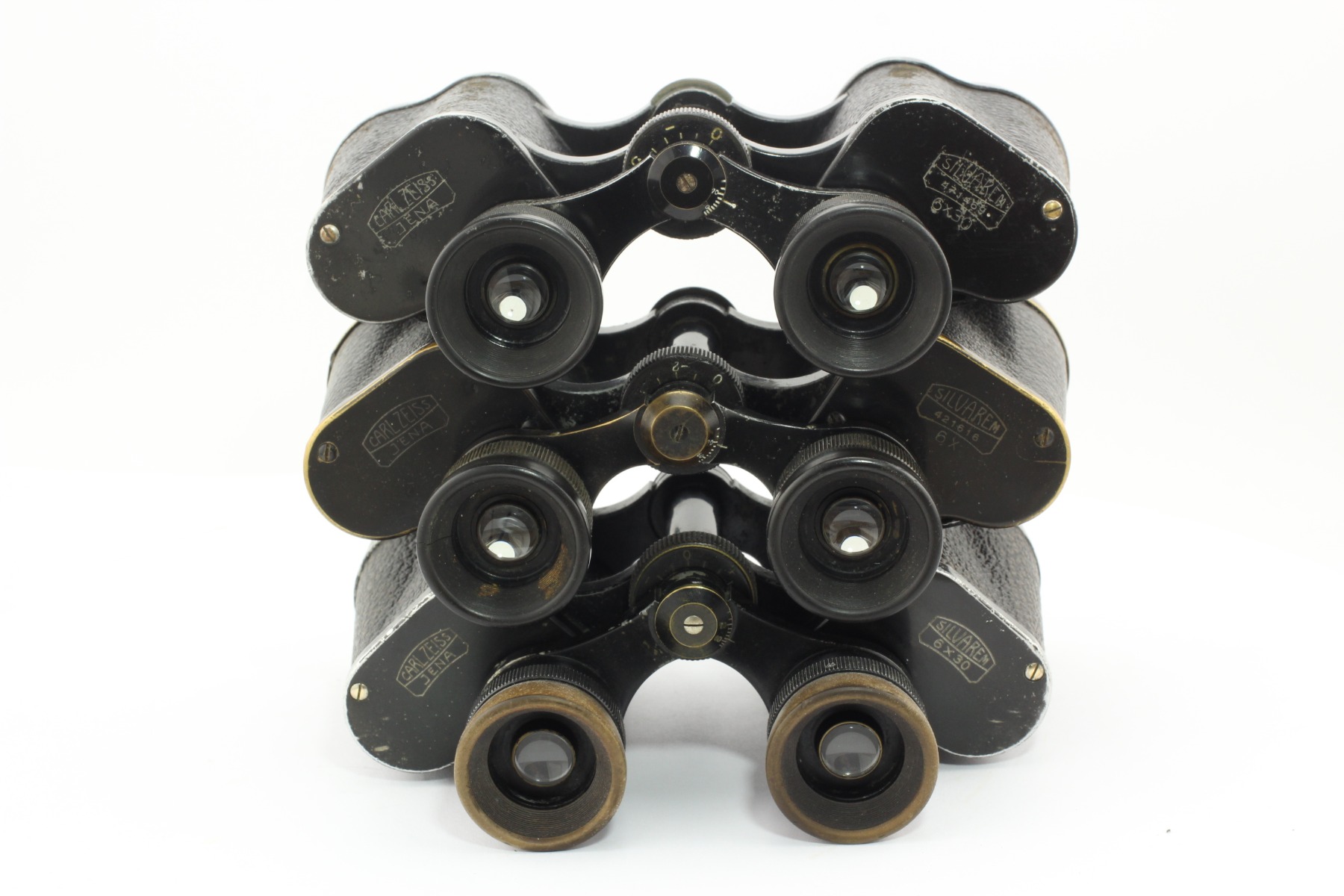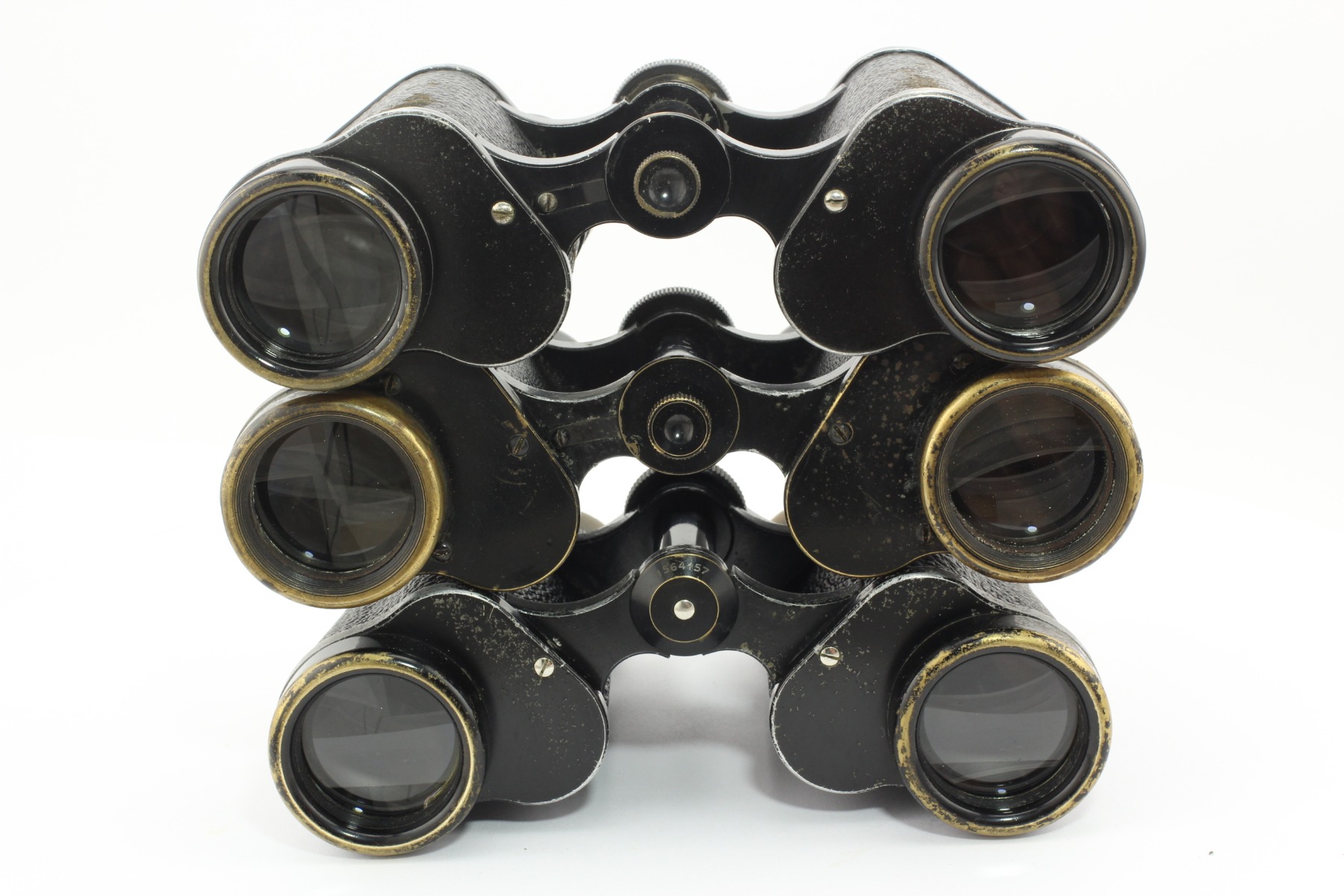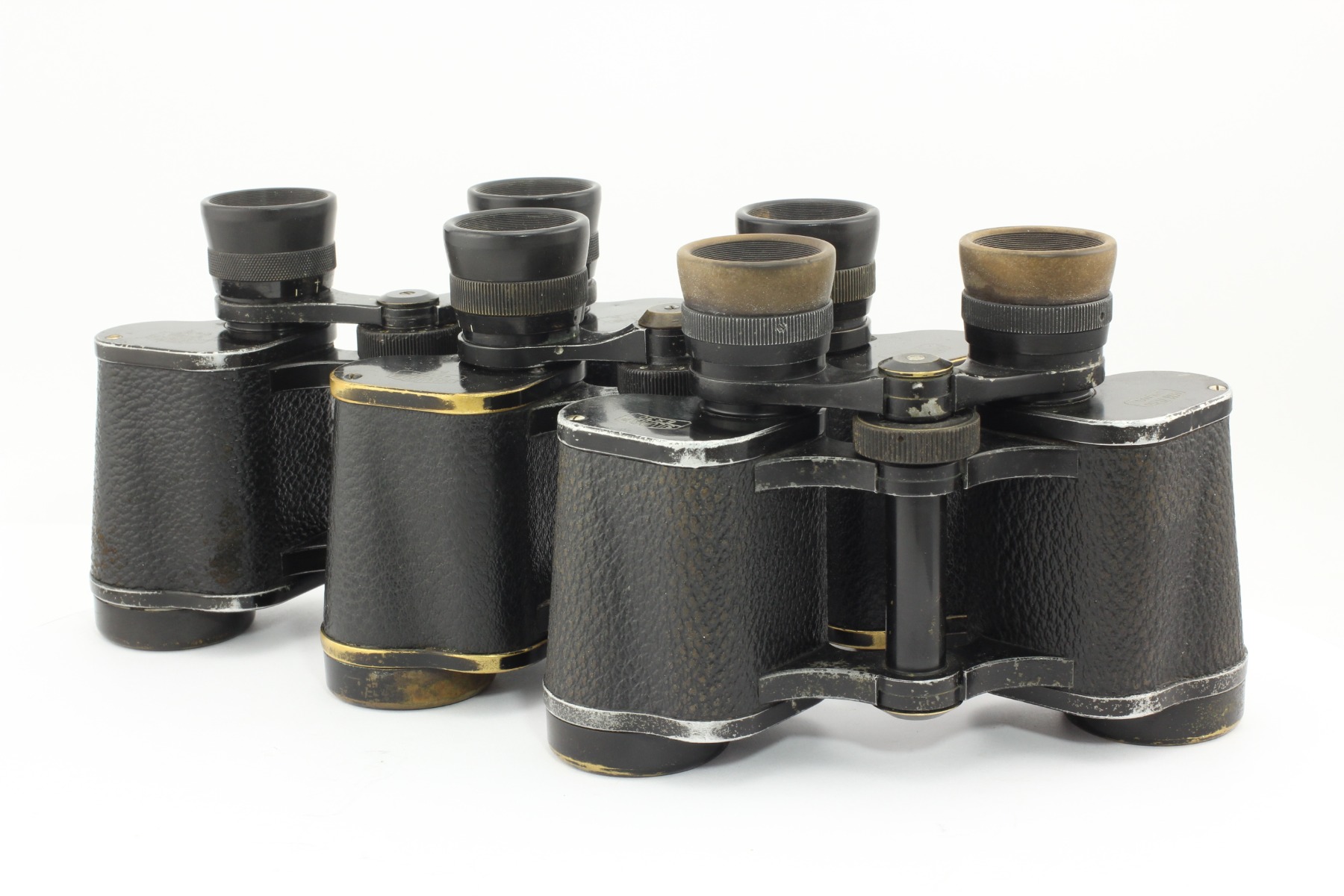Magnification: 6x
Aperture (objective diameter): 30 mm
Field of view: 8.5°
Exit pupil diameter: 5 mm
Visible field of view (eyepiece FOV): 50°
The closest focusing distance: 4.7 m
Width: 16.7 cm
Height: 11.4 cm
Weight: 665 g
Production date: 1919-1920 (?).
Binoculars Carl Zeiss Silvarem 6x30
Binoculars with central focusing appeared on the market in the middle of the 19th century. Carl Zeiss engineers were not in a hurry with such devices’ production, since they considered them less reliable and protected from dust and dirt. First prototypes of these binoculars were produced in Jena back in 1907, but only in 1909/1910 Carl Zeiss was forced to begin mass production of the devices of such design under the competitors’ pressure and because of the demand. First models of central-focus binoculars appeared in T136 catalog in 1910–those were Teletur 6x15, Telexem 6x21, Telactem 8x24 and Silvarem 6x30. Subsequently, all civilian Carl Zeiss binoculars with central focusing had an “...em” ending in their designations.
The Silvarem 6x (30) binoculars turned out to be very successful in design and optical characteristics and was produced from 1909 to 1969.
The presented specimen refers to the fourth version of this model (it was produced since 1915) and has the following features:
- the binocular design is characterized by long carcass and short lens frames (the first version of this model had another design, with short carcass and long lens frames of the double-ring type with leather coating);
- the lens caps are made with rounded edges (the previous version of this model had grooves on the caps for spurious flares minimization);
- the prism covers are made of aluminum alloy (in previous versions they were made of brass) and they are fastened with the help of one screw (in previous versions three screws were used);
- there is a diopter scale on the central focusing wheel (the first version of this model did not have it);
- the central focusing ocular bridge shoulders are flat, of the same thickness and they are made of aluminum alloy (in previous versions of this model they had fork structure, a large thickening closer to the hinges and they were made of different materials: the left shoulder was made of brass, the right shoulder was made of aluminum alloy) - see photo;
- the eyepieces front lens’s diameter is equal to 11.5 mm, the binocular’s field of view is equal to 8.5° (these values were respectively equal to 12.7 mm and 8.4° for the first version of this model);
- the eyepieces are with diagonal knurling (the previous version had a longitudinal knurling);



The binocular’s “civilian” application is proved by the central focusing mechanism and the central hinge fixture’s (clamp’s) small diameter (see photo), which has a hole for a knob (included to binoculars delivery kit), with the help of which the hinge could have been finally fixed depending on the observer’s interpupillary distance. The interpupillary distances scale is indicated on the upper hinge disk. The right eyepiece has its own focusing mechanism with a diopter scale.
The base diameter of this device’s eyepieces is equal to 24.5 mm and the top prismatic cap width is equal to 52 mm (see photo). The binocular’s case height (including the upper prism cover) is equal to 77.5 mm; the binocular’s height without lens frame is equal to 66.5 mm. The binocular’s weigh decreased from 720 g to 665 g compared with the previous version.
There are inscriptions “Carl Zeiss Jenna” on the left prism cover. There is also an inscription “Silvarem 471469 6x30” on the right prism cover. The inscription is made in block letters on the background of Carl Zeiss Tessar photo lens schematic image.
This specimen possesses an interesting feature: there is a dot at the end of serial number. It was made so, when several binoculars (models) with the same serial number were mistakenly produced (for differentiation). Indeed, according to the book of Hans T.Seeger. Zeiss-Feldstecher, Handfernglaser von 1894-1919, Modelle-Merkmale-Mythos, p. 835, the serial number “471469” gets into Turactem binoculars’ 300 pieces batch (471301-471600), which was produced in 1915, and our binoculars have features characteristic of the period 1919-1920s (?).
Previous Silvarem 6x model options can be checked by the following link: https://binocollection.com/catalog/binoculars-carl-zeiss-jena-silvarem-6x.html and https://binocollection.com/catalog/binoculars-carl-zeiss-jena-silvarem-6x-1.html
The Silvamar 6x binocular model with a similar design but with separate focusing can be checked by the following link: https://binocollection.com/catalog/binoculars-carl-zeiss-jena-silvamar-6x1.html
The Silvarem 6x (30) binoculars turned out to be very successful in design and optical characteristics and was produced from 1909 to 1969.
The presented specimen refers to the fourth version of this model (it was produced since 1915) and has the following features:
- the binocular design is characterized by long carcass and short lens frames (the first version of this model had another design, with short carcass and long lens frames of the double-ring type with leather coating);
- the lens caps are made with rounded edges (the previous version of this model had grooves on the caps for spurious flares minimization);
- the prism covers are made of aluminum alloy (in previous versions they were made of brass) and they are fastened with the help of one screw (in previous versions three screws were used);
- there is a diopter scale on the central focusing wheel (the first version of this model did not have it);
- the central focusing ocular bridge shoulders are flat, of the same thickness and they are made of aluminum alloy (in previous versions of this model they had fork structure, a large thickening closer to the hinges and they were made of different materials: the left shoulder was made of brass, the right shoulder was made of aluminum alloy) - see photo;
- the eyepieces front lens’s diameter is equal to 11.5 mm, the binocular’s field of view is equal to 8.5° (these values were respectively equal to 12.7 mm and 8.4° for the first version of this model);
- the eyepieces are with diagonal knurling (the previous version had a longitudinal knurling);
The binocular’s “civilian” application is proved by the central focusing mechanism and the central hinge fixture’s (clamp’s) small diameter (see photo), which has a hole for a knob (included to binoculars delivery kit), with the help of which the hinge could have been finally fixed depending on the observer’s interpupillary distance. The interpupillary distances scale is indicated on the upper hinge disk. The right eyepiece has its own focusing mechanism with a diopter scale.
The base diameter of this device’s eyepieces is equal to 24.5 mm and the top prismatic cap width is equal to 52 mm (see photo). The binocular’s case height (including the upper prism cover) is equal to 77.5 mm; the binocular’s height without lens frame is equal to 66.5 mm. The binocular’s weigh decreased from 720 g to 665 g compared with the previous version.
There are inscriptions “Carl Zeiss Jenna” on the left prism cover. There is also an inscription “Silvarem 471469 6x30” on the right prism cover. The inscription is made in block letters on the background of Carl Zeiss Tessar photo lens schematic image.
This specimen possesses an interesting feature: there is a dot at the end of serial number. It was made so, when several binoculars (models) with the same serial number were mistakenly produced (for differentiation). Indeed, according to the book of Hans T.Seeger. Zeiss-Feldstecher, Handfernglaser von 1894-1919, Modelle-Merkmale-Mythos, p. 835, the serial number “471469” gets into Turactem binoculars’ 300 pieces batch (471301-471600), which was produced in 1915, and our binoculars have features characteristic of the period 1919-1920s (?).
Previous Silvarem 6x model options can be checked by the following link: https://binocollection.com/catalog/binoculars-carl-zeiss-jena-silvarem-6x.html and https://binocollection.com/catalog/binoculars-carl-zeiss-jena-silvarem-6x-1.html
The Silvamar 6x binocular model with a similar design but with separate focusing can be checked by the following link: https://binocollection.com/catalog/binoculars-carl-zeiss-jena-silvamar-6x1.html
